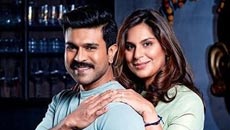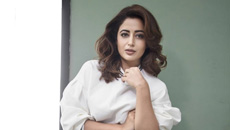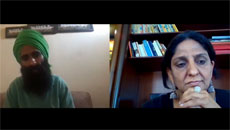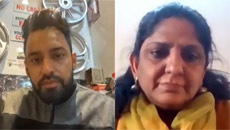Meet Helen Richardson Khan, better known as Helen, the actress who changed the entire scenario of dance in Hindi cinema from the early 50s to the late 70s to emerge many years later as a character actress in few chosen films.
From an item number, then known as a 'cabaret' dancer, Helen raised the standard of sizzling dance numbers performed in nightclubs or as the repentant vamp in many Hindi films.
She transformed this dance into an art and gave it a definite and respectable identity because, despite those scintillating gyrations in skimpy costumes, Helen exuded extreme sensuality and sex appeal without appearing either vulgar or obscene. Excerpts from an interview:
Let us hear it from the beginning.
I was born in Burma, now Myanmar, to a Burmese mother and Anglo-Indian father. My mother was a nurse and when we migrated to Mumbai, we discovered that it was difficult to maintain the family on her earnings alone.
The famous dancing star Cuckoo was a family friend. She introduced me as a dancer in the chorus in Shabista in 1951.
After being a chorus girl in many films, I finally landed solo dance numbers in Alif Laila (1953) and Hoor-e-Arab (1955.) But the turning point came with the mera naam chin chin choo number in Shakti Samanta's Howrah Bridge in 1958. O.P. Nayyar's brilliant music gave the song the zing that it demanded.
Actually, I had to quit school to work in films.
What is your take on the current girls who perform item numbers on screen?
Today's young girls are doing a brilliant job not only as actresses but also as dancers. Aishwarya and Karishma are talented actresses who also are brilliant dancers. Madhuri Dixit was equally good in dance numbers. I can't dance like them anymore.
I have no problems with item numbers because it is necessary for everyone in the entertainment industry to keep pace with time. But Vyjayantimala remains my all-time favourite and I don't think anyone can come anywhere close to her as a dancer.
I also have great admiration for the late Ragini of the Travacore sisters Lalitha, Padmini and Ragini.
Has the scenario of the film cabaret changed from your time?
Of course, it has changed tremendously. In my days, it was okay if the leading lady had two left feet and couldn't dance to save her life. It's no longer the same. The leading lady must be a very good dancer even before she makes her debut in films. They must be well trained in all styles of dance.
 So, you find that today's top
actresses are also very good dancers. However, we no longer have films totally dedicated to dance the way they
used to be in my time. Filmmakers would be the best ones to say why it's not happening anymore but it's a fact.
So, you find that today's top
actresses are also very good dancers. However, we no longer have films totally dedicated to dance the way they
used to be in my time. Filmmakers would be the best ones to say why it's not happening anymore but it's a fact.
Films like Cha Cha Cha and Jhanak Jhanak Payal Baje revolved solely around dance. Besides, leading ladies who were also dancers were extremely proficient in classical styles.
Vyjayantimala and Padmini were dancers in their own right. The trend towards Western dance styles didn't exist. Then times changed and dances were influenced by Western styles.
When did you learn to dance?
I initially trained in the Manipuri style. Then I learnt Bharat Natyam from my guru P.L. Raj, one of the leading choreographers of the time. Kathak followed this. But you can say that I am the one who introduced the cabaret and the belly dance in Indian films. I often had to dance with strikingly unusual props.
For instance, in the Merchant-Ivory film Bombay Talkie, I had to dance on the keys of a gigantic typewriter. Wigs, feathers, fluttering false eyelashes, plumes, gold paint, and everything you can think of formed part of my film wardrobe.
For many years, I would wear a body stocking under the skimpy costumes. Before Howrah Bridge, I danced to the famous number Mr. John, e Baba Khan, in Baarish starring Nutan and Dev Anand.
That made a splash and the next year, I did mera naam chin chin choo. I did perform semi-classical numbers but rarely as I did in Gunga-Jumna and Zindagi.
How do you look back to the past?
I don't. I live only in the present. That's why when people ask me whether I liked Kareena perform yeh mera dil in The Don Returns, I always tell them that she has done a wonderful job.
I have completely forgotten my own performance in Don. So, for me it's as if I am seeing the performance for the first time. I am now leading a life of semi-retirement with my husband Salim who was by my side in my most difficult days.
I am thrilled with the success of my stepchildren Salman, Arbaaz and Sohail Khan and their families along with Salim's first wife. We have also adopted a daughter, Arpita.
How did you gravitate to character roles?
They just happened. It was not a conscious decision at all. I played a character role in Sanjay Leela Bhansali's Khamoshi and offers began to follow.
Followed Mohabbatein in which I played the prim and proper headmistress of a girls' school but who is suddenly pulled in to dance she surprised everyone with her performance. I played Vinod Khanna's wife in Lahu Ke Do Rang in 1979 and the role fetched me a Filmfare Award for Best Supporting Actress.
 The following year, I played Zeenat Aman's mother in Ram Balram but my
first character role that didn't demand dancing from me was in Hum Hindustani which had Asha Parekh and Sunil
Dutt in the lead in the mid-60s.
The following year, I played Zeenat Aman's mother in Ram Balram but my
first character role that didn't demand dancing from me was in Hum Hindustani which had Asha Parekh and Sunil
Dutt in the lead in the mid-60s.But the film flopped and my career as an actress never took off. I also did Marigold last year apart from Hum Dil De Chuke Sanam where I played a significant role as Salman's mother some years ago.
There have been books written on you and even a a documentary by Merchant-Ivory productions. How do you react to these tributes?
I feel deeply honoured is all I can say. Yes, Jerry Pinto authored Helen- the Life and Times of an H-Bomb, published by Penguin a couple of years ago.
In 1973, Merchant-Ivory productions made Helen – Queen of Nautch Girls, a 30-minute documentary on my career as a dancer. Some years back, Eisha Marjara, made a feature film making generous references to my influence on her childhood and adolescence.
The Lifetime Achievement Award from Filmfare in 1998 is my greatest pride.








 Chhorii 2 Movie Review: A Missed Opportunity in the Horror Thriller Genre!
Chhorii 2 Movie Review: A Missed Opportunity in the Horror Thriller Genre! Jaat Review: A Power-Packed Action Drama Led by Sunny Deol's Unmatched Screen Presence!
Jaat Review: A Power-Packed Action Drama Led by Sunny Deol's Unmatched Screen Presence! Salman Khan Receives Fresh Death Threat, Sender Located in Gujarat's Vadodara!
Salman Khan Receives Fresh Death Threat, Sender Located in Gujarat's Vadodara! ZEE5 Unveils Teaser of 'Costao': A Riveting Tale of Courage and Justice!
ZEE5 Unveils Teaser of 'Costao': A Riveting Tale of Courage and Justice! Salman Khan's Fitness Game Is Stronger Than Ever!
Salman Khan's Fitness Game Is Stronger Than Ever! 'The Bhootnii' Announces New Release Date Amid VFX Enhancements!
'The Bhootnii' Announces New Release Date Amid VFX Enhancements! Amitabh Bachchan's Emotional Tribute to Son Abhishek's Heartfelt Gift: A Pen That Speaks Volumes in a Digital World!
Amitabh Bachchan's Emotional Tribute to Son Abhishek's Heartfelt Gift: A Pen That Speaks Volumes in a Digital World! Rashmika Mandanna Spreads Smiles With Heartfelt Video Post!
Rashmika Mandanna Spreads Smiles With Heartfelt Video Post! Alia Bhatt and Ranbir Kapoor Mark Three Beautiful Years of Marriage!
Alia Bhatt and Ranbir Kapoor Mark Three Beautiful Years of Marriage! Bollywood's Bright Future: Meet the Rising Stars!
Bollywood's Bright Future: Meet the Rising Stars! Bollywood's Burden of Legacy: Star Kids Who Stumbled on Debut
Bollywood's Burden of Legacy: Star Kids Who Stumbled on Debut Most-Anticipated Bollywood Movies to Watch in February 2025
Most-Anticipated Bollywood Movies to Watch in February 2025 SRK has agreed to do my Show: Ekta Kapoor
SRK has agreed to do my Show: Ekta Kapoor I am enjoying acting now: Shibani Kashyap
I am enjoying acting now: Shibani Kashyap